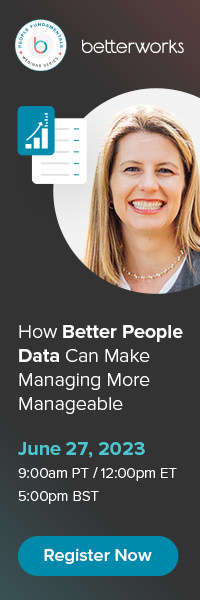As how we work changes, we’re putting more responsibility on managers. But many of them are becoming less engaged and effective. What can HR leaders do? The good news is that you have more control over manager empowerment than you realize.
RedThread research finds there are many factors driving manager effectiveness, only some of which managers control. “That’s really where performance management fits in,” says Stacia Garr, co-founder and principal analyst with RedThread Research. HR can help managers by clarifying performance goals and providing relevant data to help them lead their teams more effectively, Garr says.
We invited Garr to our upcoming People Fundamentals webinar to share her insights on reimagining performance management to empower managers and employees. Ahead of that event, we talked with her about the intersection of data, manager effectiveness, and performance enablement.
Feed data to the people who need it most
Managers are more effective leaders when they have enough information about their team’s performance to make good decisions, but not so much that they feel overwhelmed.
“If we can take some of the work and weight off managers,” Garr says, “that will give them the opportunity to be more engaged in work that is meaningful to them, reduce the overwhelming amount of work we’ve put on them since the pandemic, and will impact engagement, as well as effectiveness.”
When managers have real-time access to data, they can coach team members and influence their actions in the flow of work. “If you have information on how what you’re doing is working or is not, or needs to be adjusted or improved, then you make changes in the flow of work. Then, cumulatively, that equals higher performance,” Garr says. “It’s really about in-the-moment corrections, small corrections — not great big changes.”
Real-time performance management produces results and builds trust between managers and employees because the data is clear, and so are the goals. We know that trust is eroded by performance reviews that surprise employees with negative feedback, and yet this keeps happening because “they don’t get the information and data they need throughout the process to make adjustments, or at least to know where they stand,” Garr says.
Recognizing the opportunity and capitalizing on it are two different things. “When it comes to performance management data,” Garr says, “we find that most organizations are not providing enough of that, both to the manager and the employee.”

Identify types and sources of performance data
Data can have a huge impact on manager effectiveness — and, in turn, employee performance — but only if you can provide managers with accurate, actionable data. The good news is you likely have more data at your disposal than you realize.
“Data can be quantitative, it can be qualitative — it’s anything that can give us insights into somebody’s performance,” Garr says. “Historically, we have relied largely on feedback gathered at a certain point throughout the year, and we haven’t relied much on the kind of data that we’re collecting in our system naturally.”
Data from an annual review, for example, is divorced from daily practice and doesn’t offer a complete picture of performance. But if managers discuss performance with their team members during weekly one-on-ones, they generate dozens of data points that are more representative of ongoing performance.
“We need to be designing these systems to fundamentally collect data in a different way and then to provide that information to managers — but also, critically, to employees,” Garr says. “Our research shows that those two populations — particularly employees — rarely get data about their own performance.”
As we think through changes in performance management systems, we need to focus on a couple of priorities, Garr says. “How do we collect feedback on an ongoing basis, so we’re not relying on people and their recency biases?” she says. “How do we collect a broader set of objective data that can feed into an assessment process or the decision somebody will make on how to adjust their performance?”
With the right tools for collecting, interpreting, and delivering performance data to the people who need it, you can empower managers to become more effective and truly coach their teams.
“We need to be designing these systems to fundamentally collect data in a different way and then to provide that information to managers — but also, critically, to employees. Our research shows that those two populations — particularly employees — rarely get data about their own performance.”
Stacia Gar, RedThread Research
Reimagine how you manage performance
Rethinking something as institutionalized as performance management is never easy, but Garr explains how HR leaders can get started.
First, she says, “make sure you understand the problem you’re trying to solve within your own organization, and make sure that’s aligned to your business goals and objectives.” What’s working within the existing system, what’s not, and what do people actually need?
Many HR leaders emphasize continuous conversations between managers and their reports, but these processes are usually designed for HR compliance rather than for managers and employees. For instance, they require a lot of documentation, and they come with their own challenges beyond the ones you’re trying to solve.

Consider what managers and employees need from performance management so they can make small behavioral changes in the flow of work. “Think through: What are the feedback loops that are going to enable people to make better decisions?” Garr says. “What is the right level of feedback that people need to be getting?”
A data stream of insights from customers or clients may make sense in the context of a call center, for example, but is less useful in an internal research and development function. “What’s the measurement that’s actually going to help people make those course corrections?” Garr says.
As you redesign performance management, leave room for customization based on each department and its goals. “Set up an overall approach and vision for how this could look and where you’re going to need customization throughout the organization,” Garr says.
Want to learn more about applying data to improve manager effectiveness? Register for How Better People Data Can Make Managing More Manageable.
How Better People Data Can Make Managing More Manageable










